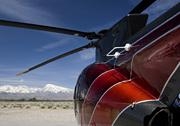Insects guide navigation for unmanned helicopters
UNSW scientists at the Australian Defence Force Academy are teaching a small 80kg unmanned mini helicopter to launch itself, hover and land in wind gusts of up to 80 kph.
UNSW scientists at the Australian Defence Force Academy are teaching a small 80kg unmanned mini helicopter to launch itself, hover and land in wind gusts of up to 80 kph.

Manned military helicopters will always be used in warfare because commanders need to deploy troops and attack military targets. But Australian scientists are applying insect navigation systems to guide unmanned mini-helicopters that could be used in counter-terrorism and defence surveillance operations.
UNSW scientists at the Australian Defence Force Academy are teaching a small 80kg unmanned mini helicopter to launch itself, hover and land in wind gusts of up to 80 kph. They hope to develop the technology to point where the mini chopper could do reconnaissance missions from land or sea.
UNSW aeronautical engineer, Matthew Garratt, and his team, are using a "hotted-up" version of a stock standard Yamaha L-15 R-MAX agricultural mini helicopter in their experiments. They have added computers, GPS, gyroscopes, magnetometers, accelerometers, cameras and laser systems that enable it to "observe" its surroundings and navigate independently.
This ability exploits "optic flow", a navigation system used by insects that allows them to fly in novel surroundings without crashing into hazards.
"Optic flow refers to the apparent motion that objects have as we move about in the world," says Garratt, a former Navy engineer. "Objects that are close to us appear to move by rapidly, whereas those that are further away move more slowly. By combining optic flow and acceleration data, the mini helicopter can determine its distance from the ground and make adjustments accordingly."
An autonomous mini-helicopter that carries radar, infrared sensors and cameras could be used for short-range surveillance -- to reconnoitre a bay which is concealed from the ship by a headland or to fly past or hover at a window in a terrorist situation or siege.
"You can send this thing off with a camera to do exploration of an inlet if you are looking for smugglers and it allows you to listen to radio signals that would not otherwise be picked up," says Mr Garratt.
"The mini-helicopter would be useful for counter-terrorism situations, especially in an urban environment where it could fly through a street or hover near a window and take a photo.
Garratt says the helicopter could be an inexpensive asset on board a small ship or boat on a surveillance exercise, operating at about $50 an hour compared with a large helicopter at $25,000 an hour.
The prospect of using self-guided unmanned aerial vehicles (UAVs) for surveillance in counter-terrorism purposes has military planners talking. For example, the ADF's Director General of Aerospace Development, Air Commodore John Oddie, recently said the ADF should accelerate its plans to trial and adopt promising unmanned systems.
"The Americans have got quite large remote-control helicopters to land on ships, but they have been on aircraft carriers or ships that have been in a harbour where it is completely calm," Garratt says. "No-one has really done a lot with landing things on small ships in rough weather and that is what we are working on."
"One of the most difficult requirements of sea operations is the need to restrain a helicopter so that from the moment of touchdown and just prior to launch, the helicopter is prevented from toppling and sliding due to ship motion.
"For this purpose, we have designed and flight-tested a series of four spring-loaded probes to engage with a deck grid to positively lock the helicopter to the deck upon touchdown and immediately prior to launch," says Garratt. "This system requires no moving parts on the ship and has been shown to positively secure the helicopter up to a roll angle of 39 degrees."